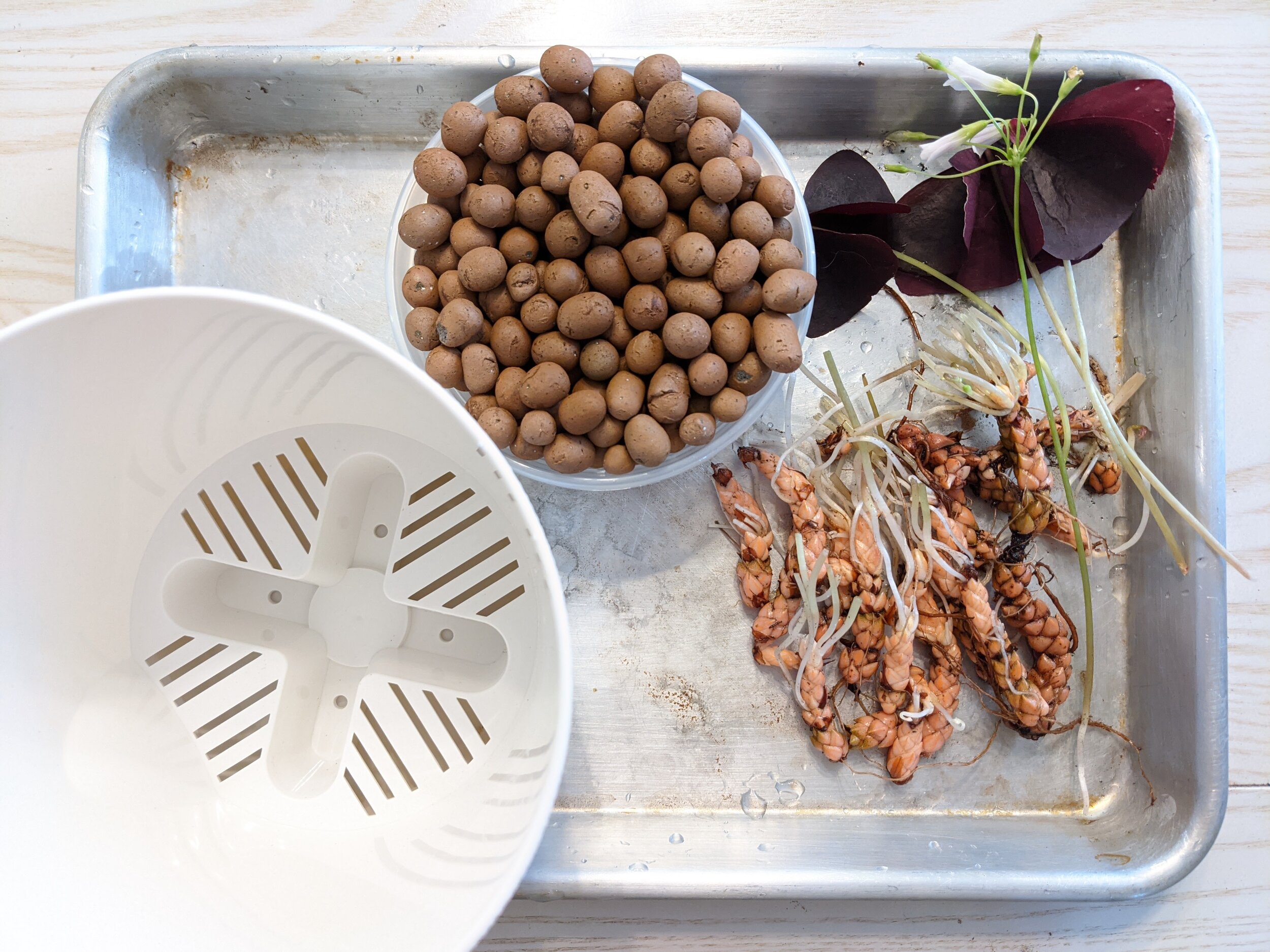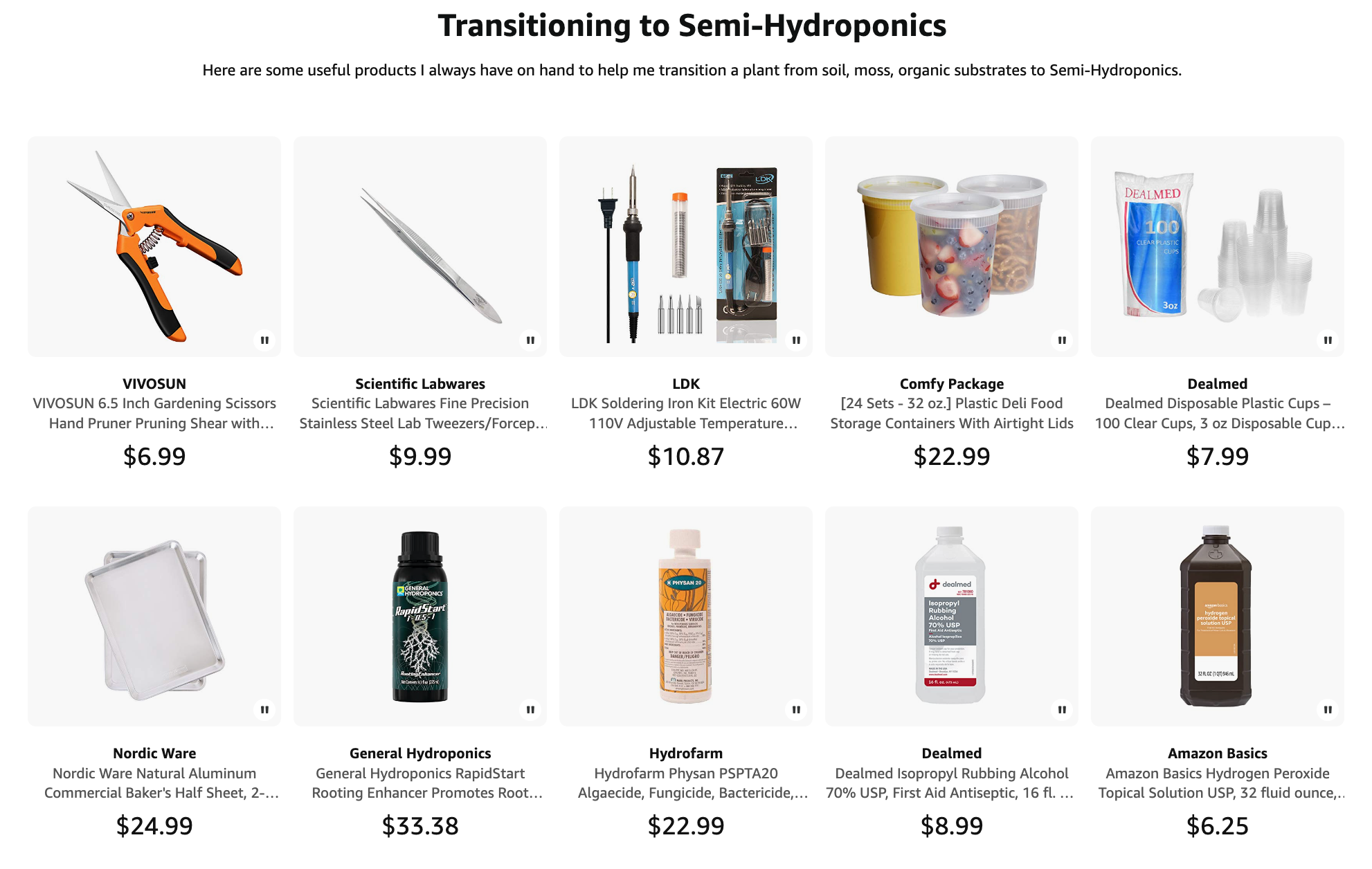Transferring Plants from Organic Medium to LECA in Semi-Hydroponics
It’s not that complicated.
It’s not complicated, but it can be time consuming depending on the root system of the plant. Here’s a step by step with some troubleshooting tips.
Step 1: Prep your LECA and Select your pot
Read the guide on LECA prep and ensure your LECA is clean and has been soaking for a few days. Make sure you have a potting plan for the plant, a few options are on the Useful Products page including some hack options. Using the nursery pot the plant came in and a deep saucer is another good option.
Step 2: Take the Plant out and Clean the Roots
The most time consuming part of this whole process is removing the plant from organic medium such as soil or bark, and ensuring the roots are clean of organic matter. Some plants such as Aglaonemas have very thick roots which makes the process very easy, and some other plants such as Hoyas that have very fine and thin root systems that cleaning them becomes extremely tedious. Thin roots plants are also harder to transition because it’s hard to remove all the organic matter. Check out the Plants in LECA section for more information on a specific plant.
Alocasia is cleaned and ready to be potted in LECA.
When soil is left on roots and placed in LECA, it will be in a continuously wet environment. When soil is left on healthy roots and in contact with LECA, the soil will continue to wick moisture from the LECA so that the roots will be continuously wet. Some plants will be ok with this and adapt to the added moisture but most plants do not thrive in these environments. Prolonged exposure to a wet environment will cause root rot, which causes the plant to decline in health.
When prepping a plant to be moved into LECA, its best to clean off the organic materials as best as you can. This will allow the plant roots to make direct contact with LECA. Once the root adapts to the environment, it will adhere to the LECA to draw moisture when it’s needed. If you can’t clean the root without destroying it, my advice is to trim it off. Any soil left on the roots (especially thin roots) will eventually lead it to rot off anyway, and even worse, affect the roots around it with rot.
If you can’t clean off all the soil, set the plant in some water for the soil to come off naturally. This will likely cause some of those roots to rot off but at least you can keep an eye on it and wait for water roots to come in.
Last resort, just can’t get the soil off - you have three options. One is to remove all of the roots entirely and treat it like a cutting, the other is to plant it anyway but flush frequently, applying products such as Physan 20, and unpotting / repotting to trim away the roots. Last option is to put it back in soil and abort!
The worst to remove is moss. If you’re dealing with a moss rooted plant, soaking helps a ton, but I basically reroot them - or avoid buying them entirely.
Step 3: Pot it in LECA
Potting a plant in LECA should be fairly self explanatory, it’s just like potting in organic media. Ensure the LECA is wet when you are potting. The most difficult is when trying to pot multiple plants into the same pot. A simple trick is to fill the pot 3/4 full with LECA, and then submerge it in water. Place your plants and lift the whole pot up at the same time.
Try to arrange the roots so they are not touching each other. This way if one root starts to decline, it is not touching another root and pass on the rot. One way to accomplish this is to trim down really long roots. This is likely scary and goes against your instincts, but by reducing the amount of roots touching each other the plant is likely to transition better.
LECA uses capillary action to draw water and stores the water within the clay interior. When placed in water, it will absorb water until it is full. Plant roots makes contact with LECA and draws water away, and the LECA absorbs more water from below.
Step 4: Watering
There are a two primary methods used in semi-hydroponics after an initial transplant. One uses water right away, the other does not.
Reservoir Method
In this method, the reservoir is filled right away with some type of liquid. Some people use plain water (tap, distilled, rain). Some add Superthrive, some add seaweed, and some use a normal nutrient solution. This decision will be dependent on the plant and observations of the plant’s health during the first few weeks of transition. I use filtered water with 6mL of seaweed and 2.5mL of Superthrive to 1 gallon.
Add liquid to the setup and your plant is transitioned! Make sure to observe the plant carefully in the first week for any signs of stress and flush the plant under water weekly until it’s established.
2022 Edit: I’ve stopped using Superthrive entirely and now I use General Hydroponics Rapid Start pretty much exclusively during a transition. Read more about why here and here.
Shower Method
In this method, the reservoir is empty after the initial potting, and left empty for a period of time (typically every day or two) until the plant is showered with water, and then returned without a reservoir. This is repeated for a period of time until the plant is fully transitioned. This method is good for plants that prefer a drier environment and can ease the transition from soil to LECA.
The shower method can be effective for a few reasons.
Keeps a drier root environment so roots don’t drown. The plant can adjust and grow “water roots” during the transition. The plant is essentially rooting in LECA and creating roots that is adapted to the new environment.
Every time the plant is showered, some more of the organic material is flushed out. Its good practice to flush a newly transitioned plant anyway, this method ensures the plant is getting regular flushing during the first few weeks.
The shower method is also not great for a few reasons.
It’s time consuming and a lot of work to remember and also to do it. The reservoir method is a lot easier.
It further stresses the plant after initial transplant because the water will cause the roots to experience movement.
It’s not great for plants such as orchids, where roots need to be hydrated, but still airy and not drowning. This method isn’t used at all for orchids due to the possibility of root desiccation.
Step 5: Observation and Maintenance
As the plant adapt to semi-hydroponics, it will show active signs of success or stress. Keep an eye on the plant and support it through the transition process.
If you observe signs of overwatering for the plant, switch to the shower method, and start using Physan 20 by spraying it into the root base. Physan 20 is an algaecide, fungicide, bactericide, and virucide. Alternatively you can also shower with some hydrogen peroxide added to the water, this helps keep root rot at bay without disturbing the root system. If the plant continues to decline, remove the plant from LECA and check for root rot. Clip off the dead roots and spray with hydrogen peroxide and try again. Do not take the plant out of LECA frequently to check roots. Plants don’t like their roots disturbed and this can add on to the stress of transplanting.
If you observe signs of underwatering for the plant, switch to the reservoir method, or shower more frequently. This is uncommon, as LECA usually holds quite a bit of moisture. This could be a sign that the potting setup isn’t correct, or the roots died in transition. (water level too low below plant’s roots).
Read about ongoing watering and maintenance routine here.
Products and Tools Mentioned in this article
All of the products mentioned are compiled in this Amazon List for easy access. I do earn a commission for your purchase. Thank you for your support!



